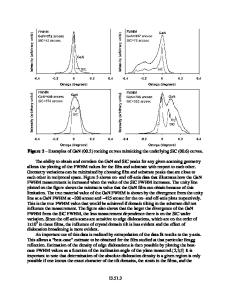The influence of substrate morphology on the thermal radiation properties of SiC coating
- PDF / 1,721,165 Bytes
- 8 Pages / 595.276 x 790.866 pts Page_size
- 26 Downloads / 353 Views
The influence of substrate morphology on the thermal radiation properties of SiC coating Fuyuan Wang1,2 · Laifei Cheng3 · Shuhua Liang1,2 Received: 15 June 2020 / Accepted: 18 October 2020 © Springer-Verlag GmbH Germany, part of Springer Nature 2020
Abstract SiC coating was prepared on the graphite substrate and the effects of substrate morphology on the thermal radiation properties of SiC coating were investigated. As the surface roughness of the graphite substrate decreasing from 2.95 to 0.68 μm, the total emissivity of SiC coating increased 28.33% at 1000 °C and 36.21% at 1600 °C, respectively. At the same time, the spectral emissivity of SiC coating on the graphite substrate all presented the obvious characteristic thermal radiation of SiC. Those results meant that the thermal radiation properties of the coating were both dominated by the substrate and coating. A simple coating model had been established to explain the effect of the substrate morphology on the heat flow between the substrate and coating. The rough substrate morphology enhanced the energy dissipation at interface and weakened the thermal radiation properties of coating finally. Keywords Substrate morphology · SiC Coating · Thermal radiation · Coating model
1 Introduction As an important ceramic materials, SiC is widely used in civil and military applications because of its excellent specific strength and specific modulus, good oxidation resistance, relative low thermal expansion, and better thermal conductivity [1–3]. Coating or film is an important form for SiC in applications, such as preservative anti-oxidation coating, wear resistant coating, solar cell film, and so on [4–6]. In service, SiC coating often works in high temperatures environment, such as heat exchange element in industry or thermal protection system in the aeronautics and astronautics [7–9]. In the passive heating system, such as the thermal protection system, SiC coating is usually used as the barrier * Fuyuan Wang [email protected] 1
School of Materials Science and Engineering, Xi’an University of Technology, 710048, Xi’an, Shaanxi, People’s Republic of China
2
Shaanxi Province Key Laboratory for Electrical Materials and Infiltration Technology, Xi’an University of Technology, Xi’an, Shaanxi 710048, People’s Republic of China
3
Science and Technology on Thermostructural Composite Materials Laboratory, Northwestern Polytechnical University, Xi’an, Shaanxi 710072, People’s Republic of China
layer to prevent oxide etch. In this case, the heat flow transfers from the coating to the substrate [8]. Whereas in an active heating system, such as the graphite heat elements with SiC coating in furnace, the heat flow transfers from the substrate to the coating [7]. In both cases, the heat transfer of coating not only involves with the thermal properties of coating and substrate, the interfacial thermal resistance, but also with the heat exchange between the coating and the external environment. The heat exchange between materials and environment is mainly dominated
Data Loading...











